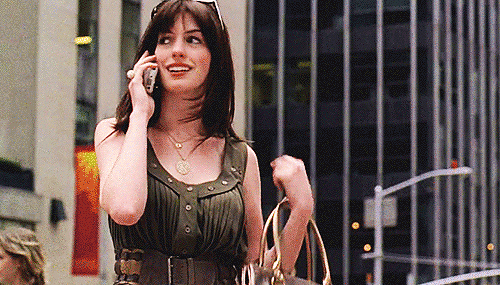The Devil Wears Prada
RUNWAY MAGAZINE

From a Human Relations/Resources standpoint, the organization of Runway magazine on The Devil Wears Prada is dismal for most involved, but effective at the same time. The success of an employer/employee satisfying my hierarchy of needs in an organizational context is contingent on meeting each of the levels adequately before proceeding to the next. This is what I refer to as a “hierarchy of prepotency” (Hierarchy of Needs, 41-42). Andrea’s need for affiliation within the company is generally not met well, due to the fact that many of her “social relationships with coworkers” are nonexistent—Emily, for example, finds her to be incompetent and simply a means of competition, and therefore does not interact socially with her and actually demeans her in the work environment. Andrea is made to feel as though she does not “belong” (Affiliation, 41). However, Andrea’s need for affiliation within her workplace is better satisfied in her relationship with Nigel. Nigel encourages interaction with her and facilitates a relationship of equal regard, which thus enables her to better do her job.
Although the affiliation need is not being fully met, the next level on the hierarchy, esteem, is oddly somehow met. As it may be assumed in the fashion industry, the organization of Runway is highly external—that is, it thrives on public recognition, attention, and overall popularity (Esteem, 41). The internal aspect of esteem is met by employees being provided many opportunities that challenge them and must be achieved, or else. Miranda Priestly, the head of Runway, is a ruthless authoritative figure who makes outlandish and extremely difficult demands for Andrea to meet, usually at the risk of losing her job. For example, when Andrea is sent on a mission to get a not-yet-released Harry Potter book for Miranda’s daughters, it is clear that Miranda expects her to be unable to rise to the occasion. Andrea uses this as motivation to complete the task and impress Miranda, thus resulting in more privileges at her job. (Esteem, 41)


Although Andrea’s internal esteem needs are technically met by the availability of challenging work given by management, Miranda’s use of these challenges border on threat and punishment, rather than giving opportunities to excel. However, the argument could also be made that this type of workplace environment helps to facilitate the next level on the hierarchy—self-actualization. The type of work that Miranda Priestly requires of the Runway employees is extremely difficult, but also demands them to do their best work and exercise their share of responsibility for the company (Self-actualization, 41). In the article “Doing and becoming: Purposeful action and self-actualization” by Fidler and Fidler, the concept of taking action and “doing” is explored and “defines doing as purposeful action that enables the nascent human to become humanized” (Fidler and Fidler, 1978). Using this definition as an argument in the context of The Devil Wears Prada, the incessant action Miranda requires Andrea to take during her employment at Runway could very well be benefitting her in the realm of self-actualization; her desire to be useful and display her responsibility is met by embarking on and successfully completing these challenges. Miranda recognizes this trait in Andrea when she tells Andrea’s potential employer that he would be a fool not to hire her.
Going off of my previous mentions of Miranda Priestly, I would like to touch on the ideas of my fellow theorists Robert Blake and Jane Mouton. Based on Blake and Mouton’s managerial grid, it is clear that Miranda Priestly has an authority-compliance management style. This managerial style involves a high concern for production within the workplace, along with a low concern for people (Authority-Compliance, 49). Miranda has arranged the infrastructure of Runway to achieve her goals for the magazine, often at the expense of the employees. It is clear that her main concern is the popularity and success of Runway, despite the effect it may have on her employees. However, those who work for her are seemingly trained to accept this fact and thus adapt themselves to fit that style. This is shown through Andrea’s transformation throughout the film; she begins as a self-motivated, opinionated employee who quickly transforms into someone who will abandon those traits to help further Miranda’s success, and thus the success of Runway magazine. This can be viewed as either a success managerially in Miranda’s case, or, in my views, a complete unsatisfactory work environment. What does Andrea personally gain as an emotionally unsatisfied employee?

Rensis Likert would likely agree with my thoughts on the above matter, characterizing Miranda as the head of an “exploitive authoritative organization”—that is, using threats and fear, top-level control of employees, and the demanding of orders to get employees to do their jobs (Exploitive Authoritative Organization, 50). The employees are not internally motivated to complete their jobs and achieve goals, but rather are intimidated into doing so for fear of losing said job. Although this seems to be very effective at Runway magazine, as it is the top fashion magazine in the movie, the highlight of much of the film is the true unhappiness most employees display whilst working there. Thus, this organization is a terrible example of the Human Relations/Resources approaches. This is because although it very much focuses on productivity and success in its industry, Runway magazine lacks in the area of individual need satisfaction (Likert’s Systems, 51). This limits potential innovation and creativity that the company could very well benefit from.

Works Cited
Fidler, Gail S., and Jay W. Fidler. "Doing and Becoming: Purposeful Action and Self-actualization." American Journal of Occupational Therapy 32.5 (1978): 305-10. EBSCO Host. Web.